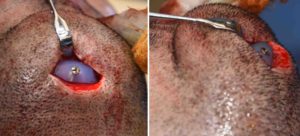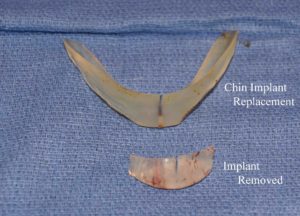Background: Chin augmentation is most commonly done using an implant. While standard chin implants comes in various styles and sizes, they all provide their effect though a horizontal increase of chin projection. While this fits in well with most patient’s aesthetic needs, some chin deficient patients have a more 3D dimensional deficiency.
Vertical deficiency or inadequate height of the lower third of the face is an often overlooked and neglected aesthetic chin issue. In some more uncommon cases a chin deficiency is purely vertical in nature. If so this is best treated by an opening wedge bony genioplasty. While a combined horizontal and vertical chin deficiency can also be treated by a sliding genioplasty operation, when only a mousy amount of vertical lengthening is needed, an implant method is less invasive and can avoid the need to disrupt the origin of the mentalis muscle that any intraoral chin procedure requires.

Case Study: This young man had a prior history of multiple chin augmentation procedures including a sliding genioplasty and a current indwelling chin implant of unknown dimensions. He desired further efforts at a better chin augmentation outcome and was clear during his examination was that his chin was vertically short as well as slightly horizontal deficient.

The need for any form of vertical chin lengthening is best determine by using computer imaging. It can also be indicated if the patient has a habit of holding their jaw slightly open to simulate a vertical longer and more protrusive chin. While the current vertical lengthening chin implant may be a bit wide for some patients, etc an easily be reshaped in surgery (customized) to fit the patient’s desired chin width.
Case Highlights:
1) Vertical chin lengthening implies a 45 degree augmentation incorporating equal amounts of horizontal and vertical projection.
2) A vertical lengthening chin implant sits on the edge of the chin bone which is stabilized both by its design and a single central screw fixation.
3) Vertical lengthening of the chin is an often overlooked aesthetic need in chin augmentation.
Dr. Barry Eppley
Indianapolis, Indiana



